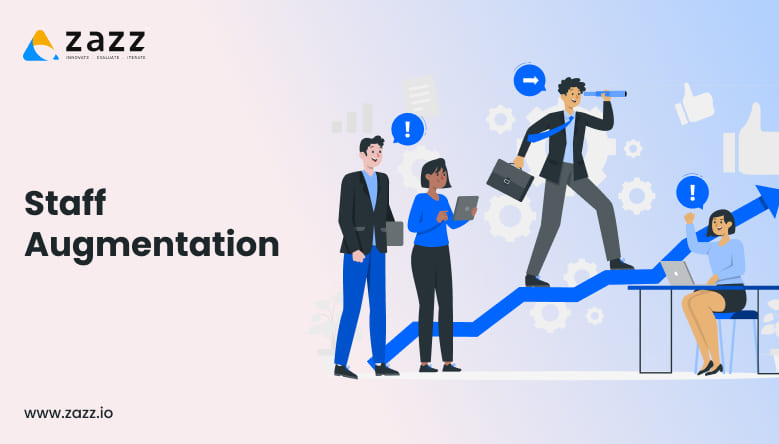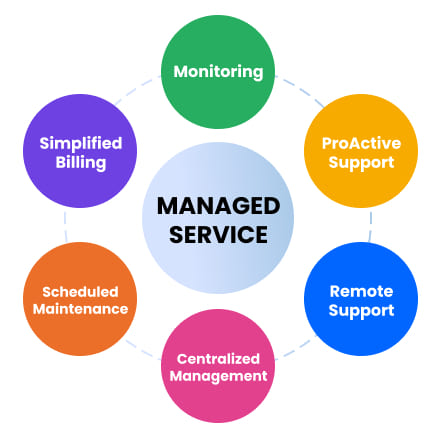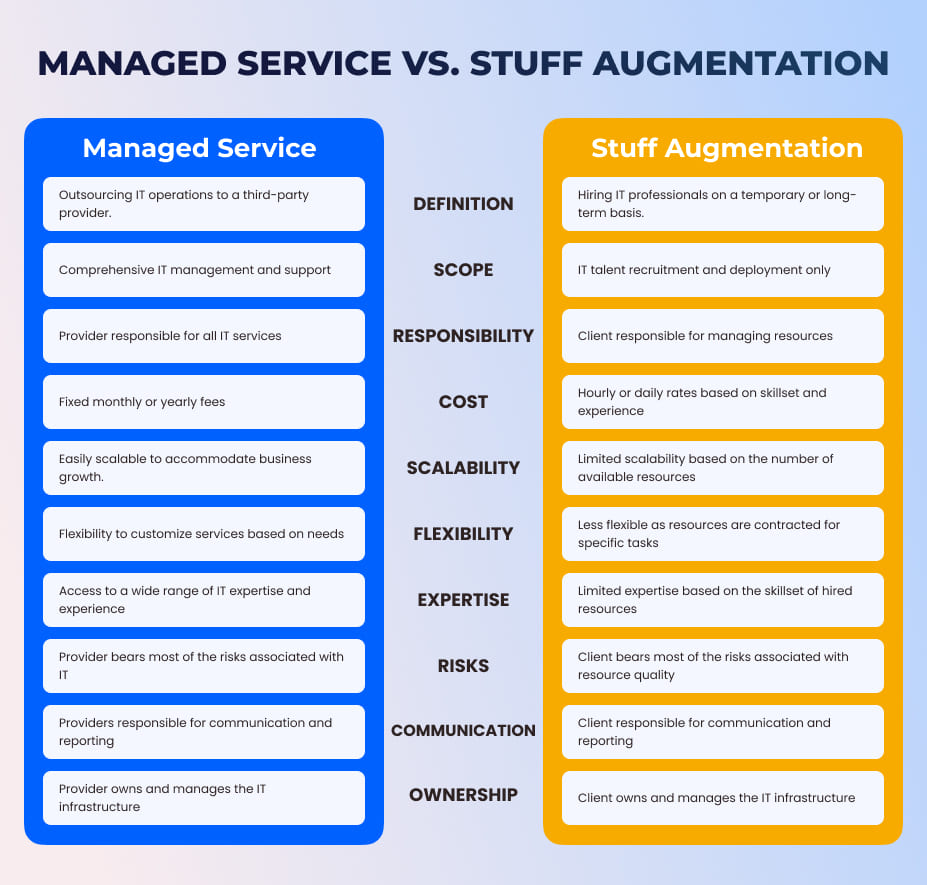
Table of Content
1. Understanding Staff Augmentation vs. Managed Services
2. Difference Between IT Staff Augmentation vs Managed Services
3. Staff Augmentation vs. Managed Services: Pros and Cons
4. Selecting the Right Model for Your Business
5. Conclusion
Every business today faces the challenge of staying lean and agile, especially when it comes to managing resources and minimizing costs. One big decision that can shape your company’s future is choosing between staff augmentation vs. managed services. Each option offers unique benefits and could be the key to gaining an edge in your industry.
In this blog, we’ll break down the pros, cons, and key differences between IT managed services vs. staff augmentation. With a clearer picture, you’ll be better equipped to choose the right path—one that fits your business needs and propels your goals forward.
So, let’s begin, and find out which model might be the perfect match for your company’s strategy.
Understanding Staff Augmentation vs. Managed Services
Outsourcing has transformed the way many businesses operate, helping them streamline processes, reduce costs, and access specialized expertise. Two key strategies in IT outsourcing services are staff augmentation vs. managed services, each serves different needs in a company.
Staff augmentation is about boosting your team with additional talent to push projects forward or fill in skill gaps. Meanwhile, managed services let you offload the responsibility of specific functions or processes to an external expert.
Let’s take a closer look at these options to help you decide which might be the best fit for your organization.
What is Staff Augmentation?

Staff augmentation is when companies temporarily bring in outside experts to bolster their existing teams. This approach is particularly useful for specific projects or to address skill shortages. It lets organizations tap into a pool of top-tier talent without the long-term commitments and costs of hiring new full-time staff. This method provides complete control over projects, helping you to effectively manage resources and deadlines.
This model is ideal for short-term needs, like tackling big projects or filling in niche expertise temporarily. Staff augmentation can also be more cost-effective than hiring permanent employees or outsourcing whole projects to managed services. It allows companies to scale their workforce up or down as needed, thus, making it a flexible and economical option.
Related reading: Guide on IT Staff Augmentation for Businesses
What are Managed Services?

Managed services offer a strategic method for businesses to delegate essential operations to talented third-party providers. This arrangement includes comprehensive long-term support and upkeep across various domains such as:
- Maintenance of cloud infrastructure,
- Security management,
- Data backup and recovery,
- Platform migration services.
Under this model, a Managed Service Provider (MSP) assumes full responsibility for these services, ensuring the efficiency and reliability of operations while adhering to service-level agreements.
Opting for managed services benefits companies by freeing up internal resources. This enables them to concentrate on primary business functions without the complexities of managing IT tasks. It’s essential, however, to select a managed services provider that aligns well with your company’s goals to avoid potential challenges and ensure a harmonious partnership.
Related reading: IT Staff Augmentation Process, Pros and Cons
Difference Between IT Staff Augmentation vs Managed Services

The choice between IT managed services vs. staff augmentation hinges on several critical factors, each influencing how businesses can best leverage external resources to meet their objectives. Here are the difference managed services and staff augmentation to help you make an informed decision:
Costs and Budgeting
Staff Augmentation: This option offers a budget-friendly solution for temporary needs by enabling companies to pay only for the hours that outsourced personnel work. This approach is particularly advantageous when a project requires additional manpower or specific expertise temporarily. It typically costs less than hiring a managed service provider (MSP) for similar tasks.
Managed Services: This outsourcing method involves a steady financial commitment to address long-term objectives. While the upfront costs might be higher compared to staff augmentation for short-duration projects, managed services provide substantial long-term value. They do this by improving operational efficiency, strengthening security, and providing continuous support and maintenance, ultimately lowering overall software development costs over time.
Flexibility and Scalability
Staff augmentation: It boosts organizational agility and scalability compared to managed services. It enables companies to quickly expand or reduce specific functions, adapting swiftly to changing requirements and situations. This model is particularly valuable for businesses dealing with fluctuating workloads or requiring unique expertise for specific projects.
Managed Services: On the other hand, managed services deliver a comprehensive approach to IT management, with the provider taking full charge of service delivery as per the agreements. Although managed services can adjust to various needs and demands, they generally lack the flexibility and scalability offered by staff augmentation.
Level of Control
Staff augmentation: This grants organizations greater control over their projects, allowing them to specify tasks and set timelines to ensure that outcomes align with their expectations and requirements. This direct oversight lets organizations actively monitor and adjust project trajectories to achieve their objectives and meet deadlines.
Manages Services: It places more control in the hands of the provider, who assumes responsibility for fulfilling service commitments. This often means organizations must give up some control, which can alter the approach to project management and execution. Despite this, managed services providers typically bring extensive experience and expertise. This guarantees that outsourced functions are handled with proficiency and precision.
Expertise and Skill Level
Staff Augmentation: This model allows businesses to selectively recruit highly skilled talent that matches the project’s specific demands. It brings advanced skills and fresh ideas to the team. Staff augmentation also facilitates the transfer of knowledge, allowing in-house employees to absorb new skills and insights. This interaction with augmented experts boosts the team’s overall expertise.
Managed Services: In this framework, businesses access a continually updated pool of professionals trained in the latest industry trends and technologies. This guarantees skilled and forward-thinking service delivery. The arrangement utilizes the comprehensive expertise of the provider’s team and introduces more creative and effective solutions than that might be generated internally.
Company Culture
Staff Augmentation: Bringing in external professionals to work with an existing team can subtly change the company culture. These temporary team members need to adapt quickly to the company’s environment. This can be challenging but also a chance for cultural exchange and growth.
Managed Services: This model often works more independently from the client’s company culture. This separation helps reduce their influence on the everyday culture of in-house employees, keeping a clear line between external services and internal operations.
Related reading: Staff Augmentation Trends to Watch
Staff Augmentation vs. Managed Services: Pros and Cons
Each model has its own advantages and possible challenges, depending on your business’s specific needs and situation. We’ll explore these in detail below:
Advantages of Staff Augmentation
Staff augmentation provides a flexible approach to scaling your workforce according to project demands. Here’s a closer look at how this model can benefit your business:
1. Selective Hiring of Professionals: Staff augmentation grants access to top talent, allowing you to choose experts who best match your needs in skills, experience, and qualifications.
2. Staffing Flexibility: Adjust your team size based on current needs. Individuals brought in to supplement your in-house team typically integrate and start contributing faster than entire teams.
3. Cost-effective Additional Skills: Staff augmentation is ideal when your current team lacks certain specialized skills necessary for a project. These professionals are already trained in their fields, which eliminates the need for in-house training. You pay only for the time they spend on your projects, not a full-time salary.
4. Full Project Control: Maintain complete oversight over your project’s timeline, execution, and quality without needing to adjust deadlines or workflow, minimizing the chance of surprises.
Disadvantages of Staff Augmentation
While staff augmentation offers numerous benefits, it’s important to consider its potential drawbacks. Below, we explore some challenges that can arise when opting for this staffing model:
1. Best for Short-Term Needs: Staff augmentation is great for filling immediate skill gaps and providing short-term support, typically less than a year. However, for ongoing, long-term needs, building an in-house team might be more cost-effective.
2. Training Requirements: While staff augmentation brings in specialized skills, you’ll still need to teach these temporary team members about your company’s specific processes.
3. Need for Strong Internal Processes: To work smoothly with external staff, especially those in different time zones, your company must have clear and established workflows and communication methods.
Advantages of Managed Services
Managed services offer a structured approach to outsourcing, which can significantly enhance operational efficiency and stability for businesses. Here are some key advantages of adopting this service model:
1. Easing Management Load: By outsourcing functions or processes to a managed services provider, businesses can lighten their management responsibilities. This allows internal teams to concentrate more on core business tasks.
2. Stable Costs: Managed services typically offer set pricing or predictable cost structures. This simplifies budget management and minimizes unexpected financial burdens from outsourced activities.
3. Expertise and Advanced Technology: Managed service providers bring expert knowledge and the latest technological advancements. This spares companies the expense and effort of developing these capabilities in-house.
Disadvantages of Managed Services
Here are the key disadvantages that businesses might face when adopting this service model:
1. Reduced Control: Handing over functions to an external provider can decrease direct control over those who carry out the tasks. This poses challenges for businesses that value close management and oversight.
2. Risk of Agreement Conflicts: Using managed services requires clear contracts detailing service levels and expectations. Any misalignment or shifts in business needs can prompt disputes or necessitate contract adjustments. This could disrupt service and impact satisfaction.
Related reading: Staff Augmentation vs Traditional Hiring
Selecting the Right Model for Your Business
Choosing the right outsourcing model is crucial for aligning with your business’s specific needs and goals. Here’s how to decide between staff augmentation and managed services based on two main business factors:
Assessing Business and Project Needs
Companies need to analyze their needs before choosing between staff augmentation and managed services, including the project’s scope, timeline, and available resources. By taking these factors into account, organizations can make an informed decision on the best outsourcing model for their unique situation.
Analyzing Advantages and Disadvantages
Understanding the benefits and drawbacks of each model is essential. Staff augmentation provides flexibility, cost efficiency, and access to specialized skills, ideal for short-term projects or variable workloads. Managed services, however, offer consistent operations, enhanced security, and long-term support, suited for businesses that need comprehensive, ongoing assistance.
By considering factors such as cost, flexibility, and level of control, companies can determine which outsourcing model, aligns best with their operational goals and resource availability.
Related reading: Benefits of IT Staff Augmentation for Enterprises
Conclusion
In summary, it can be stated that staff augmentation and managed services are quite useful in helping businesses enhance their performance and make the necessary changes to optimize their costs and get the required expertise. Thus, the assessment of the specific needs of businesses, the duration required for the project, and the amount of supervision required for the project will enable businesses to make the right outsourcing decision.
Staff augmentation vs. managed services will always depend on the organization’s requirements since both have their advantages and drawbacks.
In case you are still in doubt about which of the two options is most appropriate for you, consult the professionals at Zazz.
Recent Articles
Table of Content 1. Data Engineer vs. Data Scientist: Understanding...
Table of Content 1. What is the Carnival in Brazil?...
Table of Content 1. What is IT Staff Augmentation? 2....












